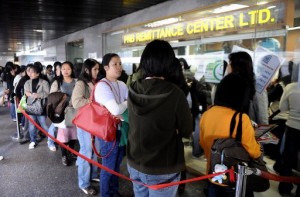In last week’s edition of Inquirer Property, experts were quoted as saying the rainy season did have an effect on home purchases. Local buyers had less time to visit project sites, and prospects more preferred to stay indoors because of the often inclement weather.
But it’s a different story for overseas Filipinos. Overseas sales, in fact, make up for the slow local takeup experienced during the rainy season.
“With close to 1 million Filipinos going overseas every year, the buying pattern in residential real estate has likewise changed. Overseas Filipinos’ purchases are concluded when they go home for their yearly holiday vacation. Based on experience, we usually notice a gradual increase in velocity in October all the way to February. February concludes the OFs’ or Fil-Ams’ vacation,” said Enrique M. Soriano III, Ateneo program director for real estate and senior adviser for Wong+Bernstein Business Advisory.
Spending shifts
Soriano added that real estate sales take a “breather” in December, as spending shifts to consumer and food items.
“However, because of the developer’s clever pricing strategies and longer payment periods, often without any downpayment, home-buying activity in the first 15 days of December actually increases,” Soriano said.
“We see no strong correlation between the rainy season and condominium sales. I would say there is more of a stronger correlation between condo sales takeups and the timing of new project launches, the flexibility of the payment terms and the availability of credit,” said Julius Guevara, Colliers International associate director for advisory services and head of consultancy and research.
Guevara added: “Furthermore, since a significant percentage of homebuyers are OFs, weather does not really affect their decision making since they tend to make that decision while they are abroad. And there are now more ways for a buyer to make a purchase decision, such as developer websites.”
Last week, CBRE Global Research and Consultancy Group told Inquirer Property that the sales trend in both vertical and horizontal developments during the third quarter of any given year shows a general decrease in sales of up to 40 percent for horizontal developments, and up to 20 percent for vertical developments. This has been correlated to the peak months of the rainy season (July to September).
“Buyers tend to cancel attendance to open-house events or sales blitzes, while brokers also tend not to arrange inspections to avoid flooding and heavy traffic during rainy days,” CBRE said.
CBRE added that for local investors, “August has been perceived as an inauspicious month to invest.”
CBRE noted that the sales rebound happening in the fourth quarter goes up by much as 60 percent “since the cool, generally dry weather permits ocular inspections, and bonuses are mostly received by yearend.”
Soriano said “the peak months for the construction sector occur during the rainy months, as general home repairs for water-damaged sections and other maintenance-related issues become immediate priority.”
Tell-tale signs
Property experts also revealed to Inquirer Property the tell-tale signs of chronic flooding, property defects and water leaks in the prospective area:
• Sandbags are present and homes are unusually elevated in the area.
• Electrical systems are poorly maintained, thus dangerous. However, electrical inspections should be conducted with the assistance of professionals, as advised by Alexis A. Acacio, director at the University of the Philippines Institute of Civil Engineering.
• Wet ceiling would hint of a leaky roof. Acacio added that when it is not raining, watch out for watermarks in the ceiling, as these would be signs of a defective roofing system. Also, look out for porous walls, firewalls and walls that are continuously exposed to rainfall. These walls manifest leaks and moisture if they are not properly made and maintained.
• If a property is adjacent or near a river or lake, check the site during heavy rainfall and watch out for overflowing.
• Take note of warped cabinets. If the wall behind the cabinet has a water leak, then the wooden cabinet would naturally warp.
